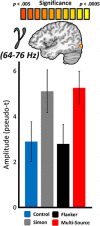Posterior Alpha and Gamma Oscillations Index Divergent and Superadditive Effects of Cognitive Interference
- PMID: 31711121
- PMCID: PMC7132948
- DOI: 10.1093/cercor/bhz214
Posterior Alpha and Gamma Oscillations Index Divergent and Superadditive Effects of Cognitive Interference
Abstract
Conflicts at various stages of cognition can cause interference effects on behavior. Two well-studied forms of cognitive interference are stimulus-stimulus (e.g., Flanker), where the conflict arises from incongruence between the task-relevant stimulus and simultaneously presented irrelevant stimulus information, and stimulus-response (e.g., Simon), where interference is the result of an incompatibility between the spatial location of the task-relevant stimulus and a prepotent motor mapping of the expected response. Despite substantial interest in the neural and behavioral underpinnings of cognitive interference, it remains uncertain how differing sources of cognitive conflict might interact, and the spectrally specific neural dynamics that index this phenomenon are poorly understood. Herein, we used an adapted version of the multisource interference task and magnetoencephalography to investigate the spectral, temporal, and spatial dynamics of conflict processing in healthy adults (N = 23). We found a double-dissociation such that, in isolation, stimulus-stimulus interference was indexed by alpha (8-14 Hz), but not gamma-frequency (64-76 Hz) oscillations in the lateral occipital regions, while stimulus-response interference was indexed by gamma oscillations in nearby cortices, but not by alpha oscillations. Surprisingly, we also observed a superadditive effect of simultaneously presented interference types (multisource) on task performance and gamma oscillations in superior parietal cortex.
Keywords: double dissociation; magnetoencephalography; multisource interference task; neural oscillations; superadditivity.
© The Author(s) 2019. Published by Oxford University Press. All rights reserved. For permissions, please e-mail: journals.permission@oup.com.
Figures






References
-
- Andersen P, Andersson SA. 1968. Physiological basis of the alpha rhythm. New York: Plenum Publishing Corporation.
-
- Aron AR, Robbins TW, Poldrack RA. 2004. Inhibition and the right inferior frontal cortex. Trends Cogn Sci. 8(4):170–177. - PubMed
-
- Aron AR, Robbins TW, Poldrack RA. 2014. Inhibition and the right inferior frontal cortex: one decade on. Trends Cogn Sci. 18(4):177–185. - PubMed
-
- Baayen RH, Milin P. 2010. Analyzing reaction times. Int J Psychol Res. 3(2):12–28.
-
- Baddeley AD, Baddeley HA, Bucks RS, Wilcock GK. 2001. Attentional control in alzheimer's disease. Brain. 124(Pt 8):1492–1508. - PubMed
Publication types
MeSH terms
Grants and funding
LinkOut - more resources
Full Text Sources

